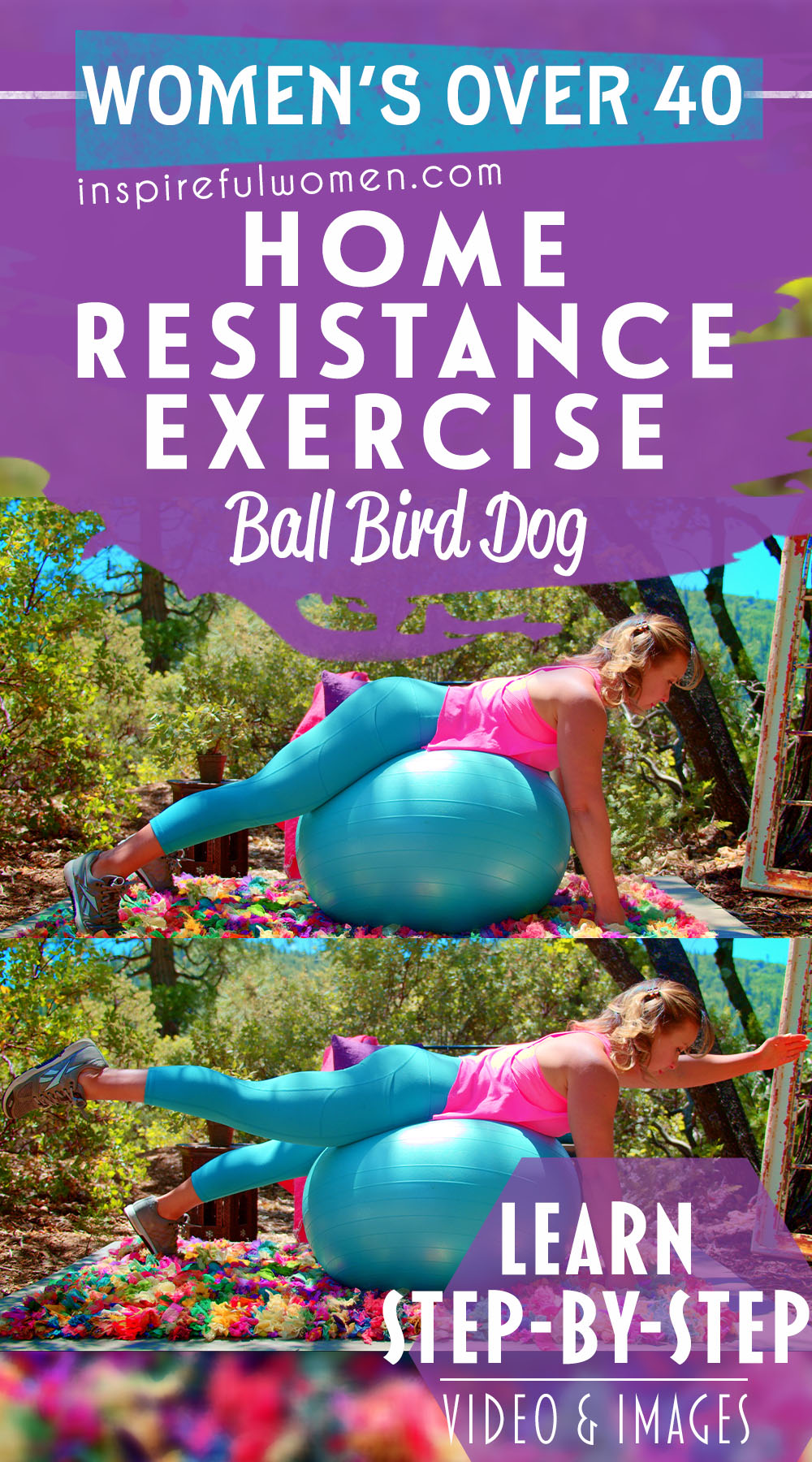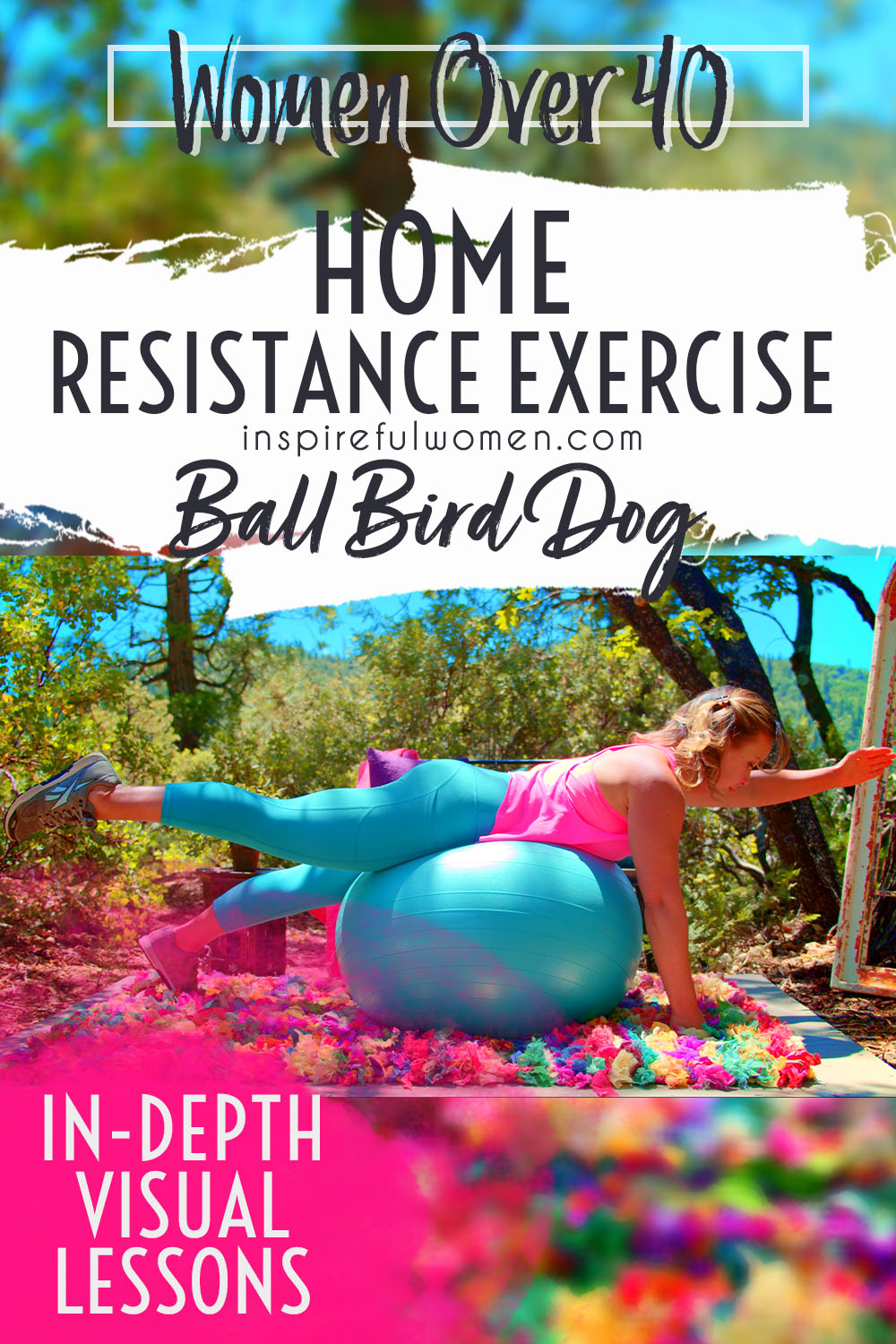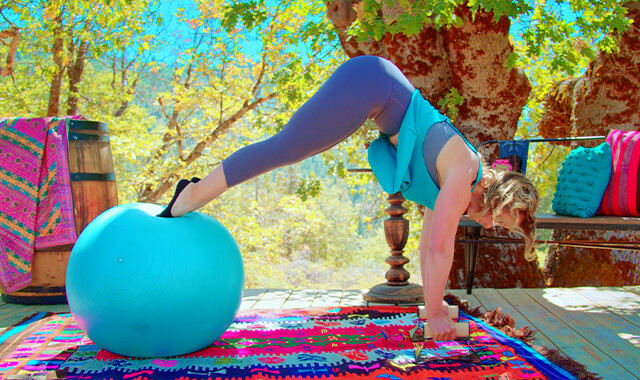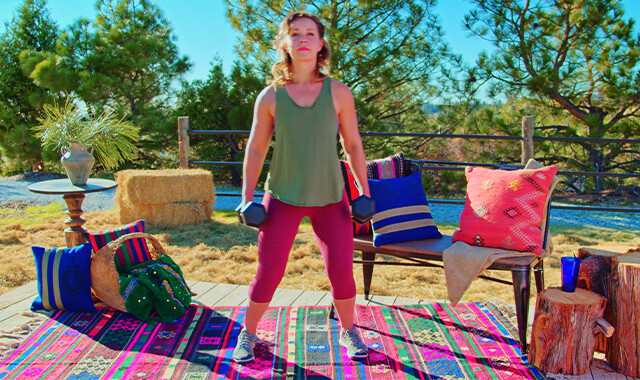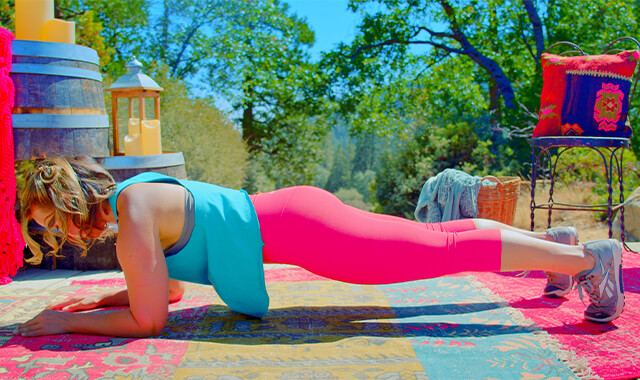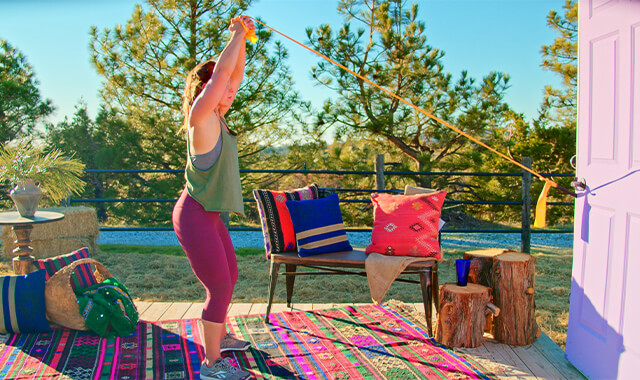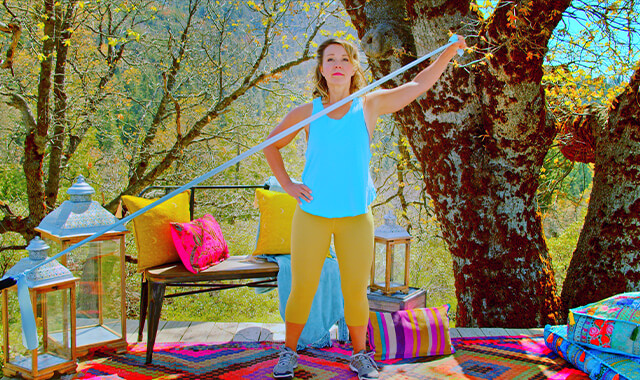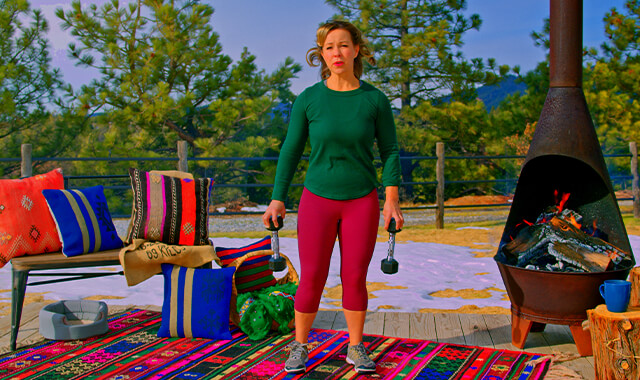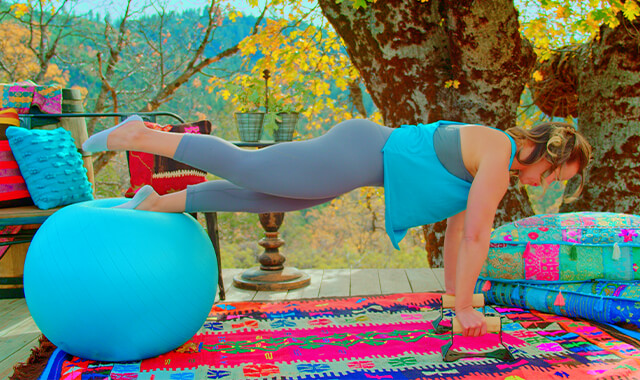Ball Bird Dog - Core & Back Exercise
How to Do the Beginner Bird Dog On Stability Ball | In-Depth Guide [VISUAL LEARNERS] Beginner
Proper Form & Common Mistakes | Home Resistance Training
WHAT DO YOU WANT TO SEE?
QUICK DEMO
QUICK DEMO
MUSCLES THIS WORKS
MUSCLES
MAIN MUSCLES WORKED IN the Swiss Ball bird dog
BACK EXTENSOR MUSCLES
Which consist of: Erector spinae, Multifidi; Quadratus Lumborum, Obliques
OTHER MUSCLES WORKED (fyi, tons!):
- Latissimus Dorsi
- Gluteals
- Transverse Abdominis
- Rectus Abdominis
STARTING POINTERS
Starting Pointers
WHAT WE'RE DOING TODAY
ALL WE'RE DOING:
From your hands and knees with a stability ball under your torso, lift one arm and the opposite leg up. Like you're a highway sign pointing in opposite directions. Hold.
This is a great beginner variation of the bird dog. The exercise ball helps support your torso while you adjust to the balance needed to do this move without the ball.
The bird dog exercise is a great exercise for developing core strength and stability. The stability ball bird dog is also a good option to use for strengthening the muscles of the back, shoulders, arms and hips. The exercise works the muscles of the back diagonally - meaning that the arm and opposite leg are lifted up at the same time creating a “muscle sling” that supports your back. This is the same pattern of muscle activity used in walking - reciprocal arm and leg movement - as the leg extends back the opposite arm moves back.
HOW TO DO THE EXERCISE
LOOKS
HOW Gym Ball Bird Dogs SHAPE OUR BODY
Upright posture, strong, graceful movement - having a strong core makes it easier to move the arms and the legs with control and power.
PROPER FORM
PROPER FORM: Ball Bird Dogs
EQUIPMENT, SETS & REPS
EQUIPMENT
Stability Ball
SUGGESTED STARTING WEIGHT FOR WOMEN:
None
SETS & REPS:
8 - 10 on each side with good form (alternating sides: one arm and opposite leg, then the other arm and the opposite leg).
PACE:
Slow with control.
BODY POSITION
BODY POSITION FOR THE Stability Ball Bird Dog
BODY STANCE: Kneel with the ball in front of you. Place your torso on the ball and push with your feet to roll over the ball so that your belly is on the ball, your shoulders and upper chest off of the ball. You might need to play with the placement of the ball underneath you - it's good to shoot for feeling like you have some weight over your shoulders- meaning it shouldn't feel like your arms aren't working at all- they should be bearing some of your weight if possible.
ARMS: Shoulders in front of the ball - keep the space between your earlobe and the top of your shoulder. Hands about under shoulders, shoulder width apart. Arms straight, the elbows soft. For the arms, if you work on holding your arm straight overhead with the longer hold you should feel it in your upper back/scapular muscles. It doesn't matter how their hands are, so much of that is dependent on the size of your ball and the comfort of your wrists.
You should feel your lats working - that is one problem that I had with the ball version - I don't feel my lats quite as much because the ball is supporting the midsection.
HANDS: Palms or fingertips on the floor to stabilize your upper body - this will be dependent on how big your ball is, there should be some weight on your hands.
LEGS: Legs straight out behind you with toes planted in the floor. The CLOSER your feet are together the easier it will be to lift one leg up.
NECK: Neutral throughout the exercise (this exercise works the muscles of the neck also so it is important to have your cervical spine in neutral).
HOW TO DO
HOW TO DO Ball Bird Dogs
CUE: Imagine a teacup filled with hot tea sitting on your low back. As your arm and leg lift up, the teacup should remain level to prevent spilling.
With slow control, lift your one arm and your opposite leg until they are parallel to the floor.
Keep your arm in line with your shoulder and your leg in line with your hip. [The height that your arm and leg is lifted to is dependent on your ability to maintain a neutral spine, lower than torso level is ok as you work on getting stronger.]
Feel one line of energy from your fingertips to your toes. As if you are reaching your hand and foot towards the walls. This will help activate the core.
Hold for 5-8 seconds. Lower your arm and leg back to the floor with control.
Repeat with your other arm and your opposite leg.
Alternate between sides (left arm, right leg, next rep - right arm and left leg. This helps teach your body to make adjustments in muscle activation.
PROGRESSING THE MOVEMENT:
ME: Are there any tips for transitioning from This to the regular bird dog in the sense of ways to make it so they are gradually supporting more of their weight on the ball? Only because when I did this yesterday, especially for my upper body my positioning felt like my arms didn’t need to bear almost any of my weight and so I wondered is there a way to increase the level of weight bearing on the ball as able before moving straight to complete upper body weight bearing with the regular bird dog? Like less air In the ball or the smaller ball will still support them some but would start to require they push up with their arms in order to have a straight arm underneath them, etc- like that- would that help?
CAROL: Absolutely, in fact when I do it I am much further forward on the ball so that more of the weight is on my hands and less on my feet.
I think the smaller ball and pushing up to get their arm straight would encourage spinal extension. I think a lot would depend on what they were struggling with for the unsupported bird dog. Core, arm,leg weakness, balance or coordination. The transition would be to do the regular bird dog arms only, legs only, or in two steps so that they can address their weakness. They could do the same thing on the ball, legs only, arms only, or two steps. But I think if they have core weakness this would not really help them.
HOW TO SAFELY GET OUT OF THE EXERCISE
Use your arms to push yourself back on the ball as you lower your knees to the floor.
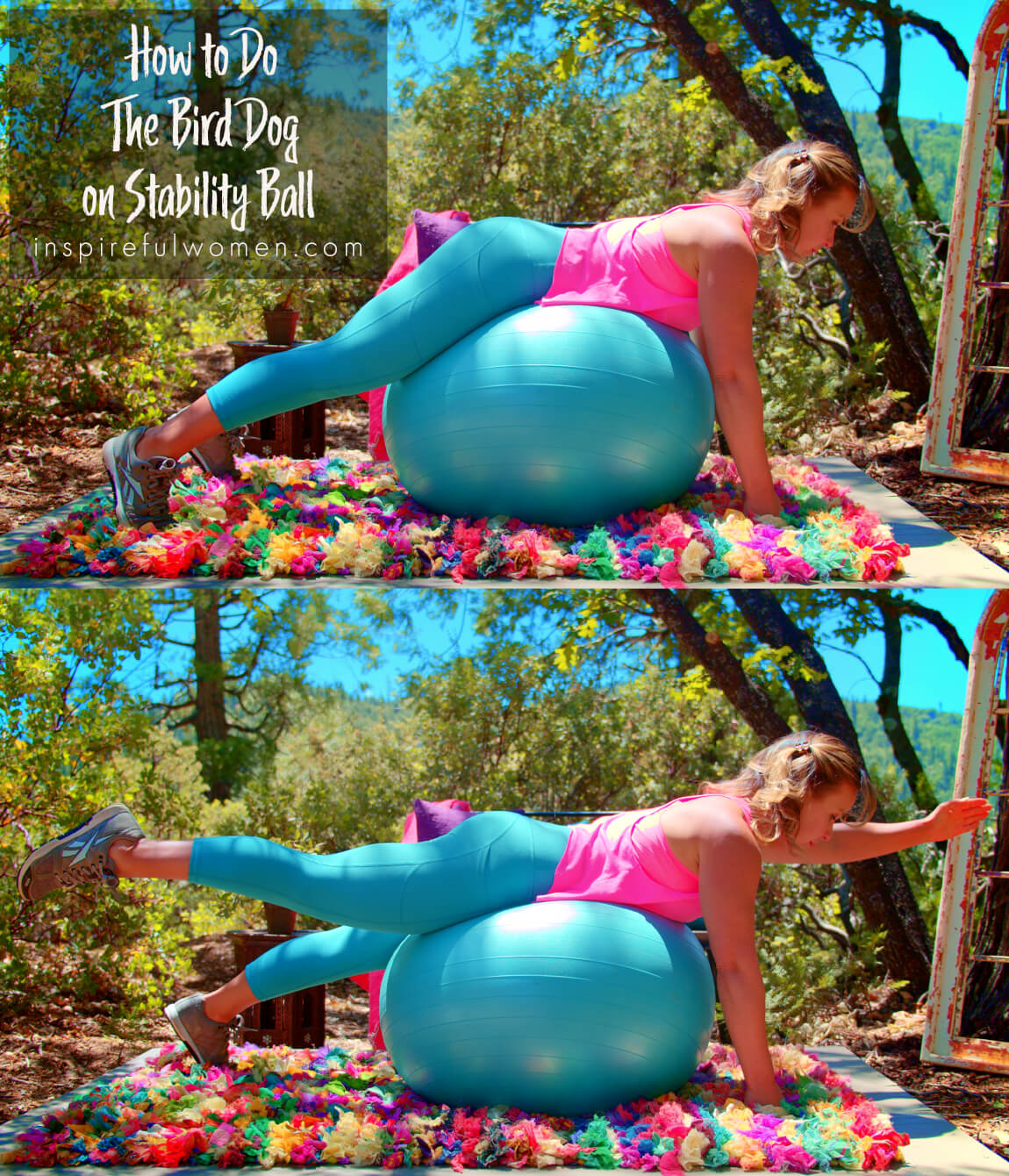
COMMON MISTAKES
COMMON MISTAKES
WHAT TO AVOID WITH THE Stability Ball Bird Dog
KEY TIP:
Guess what? Good news! Many avoids are the same for most movements. Once you learn the basics, there's really only a few extra avoids for each individual movement.
1. Avoid Moving Torso
AVOID: Moving the torso
WHY NOT?
- Moving through the spine will not work the muscles as intended and may irritate the joints of the spine.
WHAT TO DO:
- The goal of the exercise is to keep the spine in neutral as you move the arm and leg.
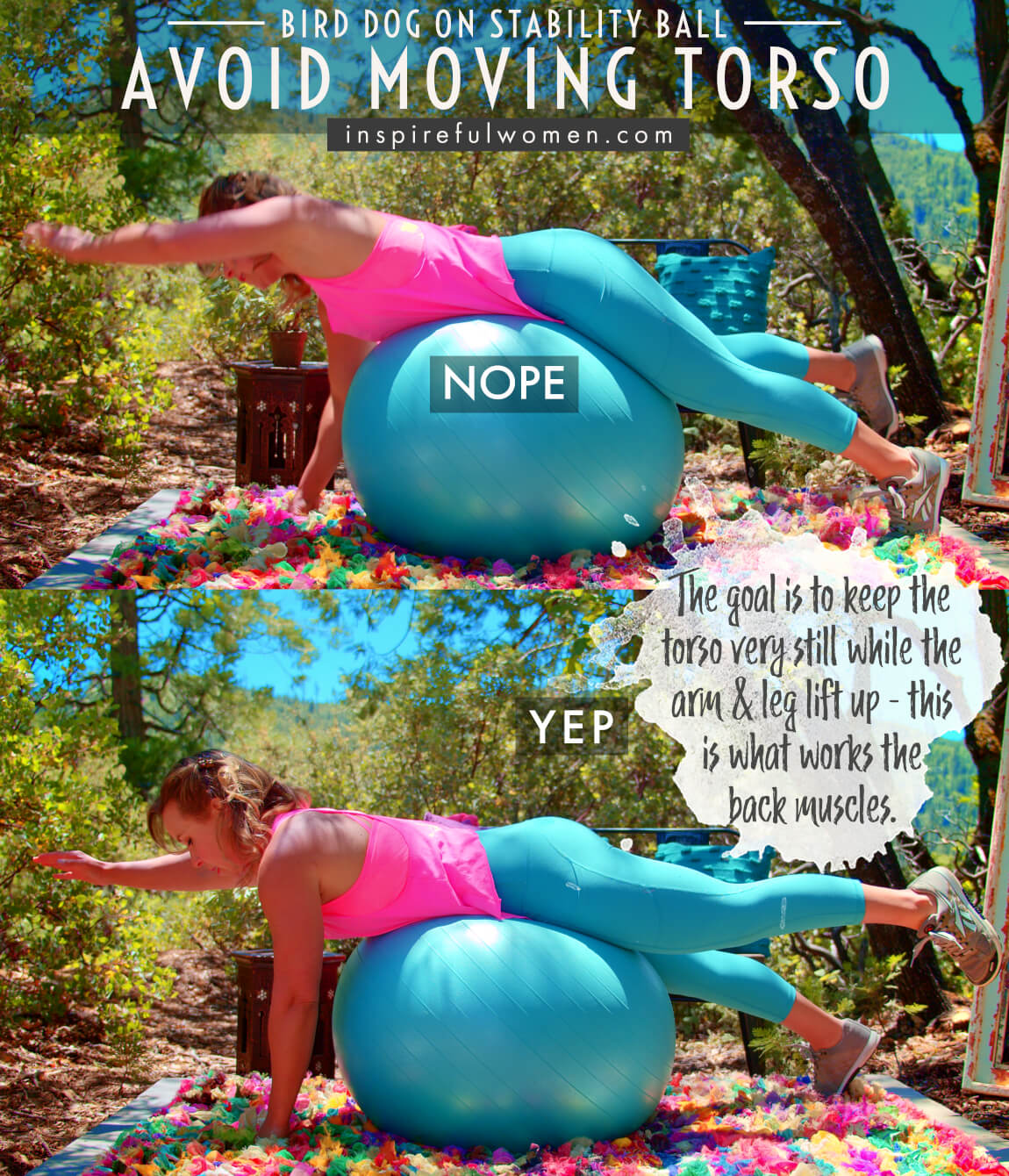
2. Avoid Lifting Too High
AVOID: Lifting the leg or arm too high.
WHY NOT?
- This will cause back to arch.
- Exercising with the back arched can lead to irritation of the spinal joints and can cause damage over time
- Working with the back in extension will not achieve the goal of the exercise. The goal is to strengthen the muscles in a neutral spine position.
- There is no benefit to lifting the leg or arm higher, it decreases the muscle activity of the arm and leg.
WHAT TO DO:
- Only lift as high as the leg and shoulder can move from their joints.

3. Avoid Lifting Outward
AVOID: Avoid letting the lifted leg/arm move outwards.
WHY NOT?
- Letting the leg /arm drift inward will decrease the demand on the back extensors.
- When the leg/arm lifts up off of the floor the pelvis/upper back will attempt to rotate down towards the floor, it is the job of the back extensors to hold the pelvis and shoulders level.
WHAT TO DO:
- Keep the leg aligned with the hip.
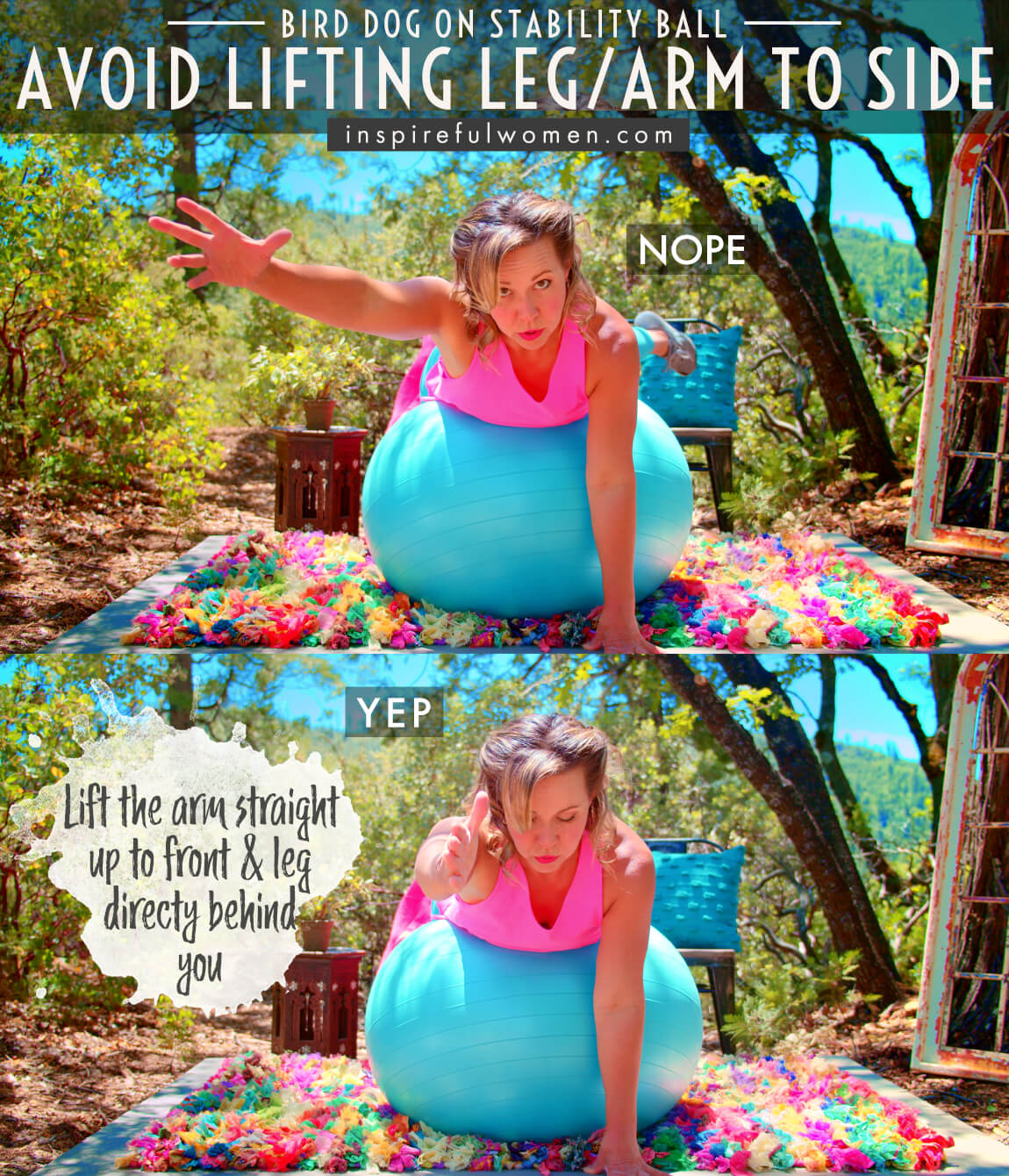
WHAT WE'RE DOING TODAY
WHAT & WHY
BENEFITS OF TRAINING THE back extensor MUSCLEs
WHAT
You might be thinking, hey, I'm a human. I'm not a bird. I'm not dog. And I definitely ain't a bird-dog. But stick with me ladies, the exercise with the odd name has a very cool point to it..
The bird dog is used for exercising the muscles of the core, especially targeting the muscles that prevent your spine from bending forward. That rounded slumping back look has never been attractive has it? And I certainly don't need to look any shorter.
This exercise also works the muscles that move and stabilize the shoulders and hips. The movement is done on your hands and knees with your spine held very still in a neutral position.
One arm and the opposite leg are lifted up. Lifting the limbs will throw your body off balance and you will need to work to keep control. This requires a lot of concentration, coordination, and muscle control.
THE COOL THING ABOUT IT:
There's lot of body parts remaining still. Which gives us the sense of chillness, peacefulness. This is an ultimate anti-hiit-get-your-knees-high-in-the-air exercise.
The bird dog is good for learning to move through the shoulder and hip joints while keeping your spine very still.
WHAT'S HARD ABOUT IT:
Turns out, unbeknownst to me before, it's actually very difficult to not move - to keep your torso still while lifting an arm and leg up. So at first, we might feel like losers when we see how shaky we are. You might even start wishing I'd ask you to hop up and give me 20 jumping jacks instead. But stick with it. You will improve in no time and you will feel SO good to see your ability to control your body movement improve.
In order to stabilize the low back when you lift the arm and opposite leg, you need to use the latissimus dorsi muscle that helps to connect the upper body to the lower body. To do this, once the arm is lifted up into place, pull the shoulder blade down the back to activate the connection between the upper and lower body.
TO GET THE TRUE BENEFIT: HOLD THE POSITION
The other important part of this exercise is to hold the position at the end range with good control - the exercise trains the muscle for endurance - the ability to work for a long time. That is how the core muscles function most of the time, so it's practical to train the core in this way.
This is a goal to work up to, first concentrating on being able to get into the position with good form, and then slowly being able to increase the time that you hold the position.
This is really important for training the body to move in ways that protect the spine, hips and shoulders from injury and damage over time.
BACK PAIN ANYONE?
The Bird Dog is commonly used for the treatment and prevention of back pain. There are two training techniques that are commonly used to increase the endurance of the stabilizing muscles:
1) Get into the position and hold the position still for a set number of seconds, or until you are not able to hold good form;
2) Hold the position very stable and move the arms and/or legs for a set number of reps.
Learning to get into the position and holding it stable is the first goal. Once that is mastered, adding movement of the arms and legs is the progression.
WHY BOTHER DOING IT?
WHY
WHY DO WE EVEN CARE?
TRAINS CORE MUSCLES FOR ENDURANCE SO YOU DON'T FALL OVER
The back extensors work with the other core muscles to hold you upright and stable. The muscles work constantly but at low levels - meaning that the muscles are not producing a lot of force, but they are always active just to keep you from falling over - all the time, both in standing and sitting. They become more active when you lean forward. The muscles need to work to stop you from falling forward.
TRAINS BACKS MUSCLES TO WORK IN THE SAME WAY THEY WORK WHILE WALKING
It's probly going to sound weird to say that being on your hands knees can translate over into how we walk upright, but stick with me!
In the Bird Dog, one arm and the opposite leg is lifted. This activates the back muscles in a diagonal pattern. This is the same way that the muscles are used during walking, called “reciprocal arm and leg movement” - as one leg extends back the opposite arm moves forwards. Which is what we're doing in the Bird Dog.
Well why don't we just walk around then instead of doing this whole rigamorole on our hands and knees huh Rayzel? Well, it has to do with gravity. By getting down on our hands and knees, our back muscles will now be working against gravity much more to lift our arms and legs, which is what will really challenge these muscles.
HELPS US USE OUR ARMS & LEGS WITHOUT INJURING OUR SPINE
Training the muscles of the back to hold the spine in a good position while you move your arms and legs will improve your ability to use your arms and legs with less risk of injuring your spine.
I'm cool with being able to not hurt my back, you?
IMPROVES OUR SENSE OF SELF
Not the psyche-type sense of self, although I'm super into that too, but this sort of exercise, helps us improve our sense of where our body is in space.
Exercises that involve weight bearing through the joints will stimulate the receptors in the joints that tell the brain where the body is in space - these are called proprioceptors. This is part of training coordination and balance.
In the hands and knees position, the joints and muscles need to make tiny adjustments to keep the arm and hip stable - this is all coordinated through the communication between the joints, brain and muscles. As the working arm and leg move, the brain will send information to the muscles to make tiny adjustments in order to stay balanced on the stabilizing arm and leg.
When you do exercises that focus on very deliberate, stable and controlled movement you are strengthening the connections between the brain and the muscles.
EVERYDAY LIFE
EVERYDAY LIFE &
MUSCLE FUNCTION
HOW WE USE OUR Back extensor MUSCLES IN EVERYDAY LIFE
1. THE MUSCLES ON THE BACK OF THE TORSO WORK TOGETHER TO HOLD THE SPINE STILL DURING ALL UPRIGHT ACTIVITIES
- Sitting
- Standing
- Walking
- Lifting
- Pushing
- Pulling
- Carrying
2. THE BACK EXTENSORS WORK TO PREVENT THE BODY FROM FALLING FORWARD ANYTIME THE BODY MOVES FORWARD FROM BEING PERFECTLY UPRIGHT
- Forward head posture
- Leaning forward
- Reaching
3. BACK STABILIZERS WORK TO PREVENT ANY MOVEMENT OF THE SPINE OUT OF NEUTRAL AND INTO FLEXION
- Walking
- Reaching - when the arm moves forward
- When lifting one leg or arm - this will cause the spine to want to rotate
- Especially when leaning over or on hands and knees because of the downward pull of gravity
SCIENCY STUFF
SCIENCY STUFF
SPIFFILICIOUS FACTS ABOUT MUSCLES & MOVES
The erector spinae muscle is a large group of muscles that run the entire length of the spine - from the base of the skull down to the sacrum. The muscle is divided into different smaller groups based on the attachments - iliocostalis, spinalis, and longissimus.
There are more muscles that lie under the erector spinae that are also back extensors: semispinalis, multifidi, rotatores, interspinalis and intertransversarii. All of the muscles can help to extend the spine to increase the lumbar and cervical curve and stabilize the spine.
They are assisted by many layers of very strong ligaments, and the vertebral discs. The muscles will be most active when you are bent forward with the hips flexed 90 degrees, as you lean over further the muscles become less capable of preventing spinal flexion. In this position, we rely on the ligaments and discs of the spine to control movement.
ALLLL MUSCLES & WHEN
ALL MUSCLES WORKING & WHEN DURING THE Ball Bird Dog
Over the ball in the quadruped position: the extensor spinae, deep spinal extensors (semispinalis, multifidi, rotatores, interspinalis and intertransversarii), quadratus lumborum, and obliques contribute to holding the spine in neutral - at rest with the hands and feet on the floor, this is minimal, as the leg and arm are lifting this will increase.
The arm and shoulder blade muscles (deltoids, biceps, triceps, teres major, muscles of the forearm, scapular muscles, rotator cuff muscles latissimus dorsi) work to hold the upper body still.
The arm lift: the biceps and anterior deltoid lift the arm out over head. The trapezius and serratus anterior rotate the scapula (shoulder blade will rotate upward. As the arm reaches forward the shoulder blade pulls down the back to activate the lats which help to stabilize the spine.
The leg lift: the gluteus maximus and hamstrings take the leg back towards neutral (from flexion). The back extensors and hip abductors and external rotators (of the support leg) will need to work to maintain a level low back and pelvis.
PIN IT FOR LATER!
